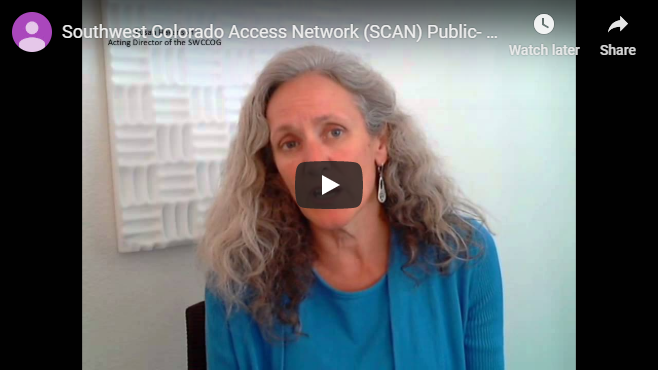
The Red Fog of Communism in the Dark Web of the Deep State
By Vicky Davis
The regional power structure of the Councils of Government, with anchor institutions that are outside of our elected representative government, are building a private network with access to both public and private data. These networks are linking through to a continental regional system, linking through to a global system of dark fiber, fiber optic sensors and data, and the end result is a dark system of totalitarian control – outside the boundaries of lawful government. The ultimate Panopticon.
The Councils are unelected commissions that are cross-jurisdictional, collectivist management organizations. They are comprised of at least one representative from each lawful jurisdiction after signing an intergovernmental agreement for the jurisdiction they were elected to represent. The Economic Development Administration (EDA) along with the Department of Transportation are the cancerous agencies leading the conversion to the system of regionalism. The regions overseen by the unelected COGs are economic regions collectivizing the lawful jurisdictions within the EDA’s economic district system.
The EDA was established in 1965 as one of the Great Society Programs of John W. Garner (Carnegie Foundation). Click the title below to read the mission statement of the EDA from the 2006 edition of the website:
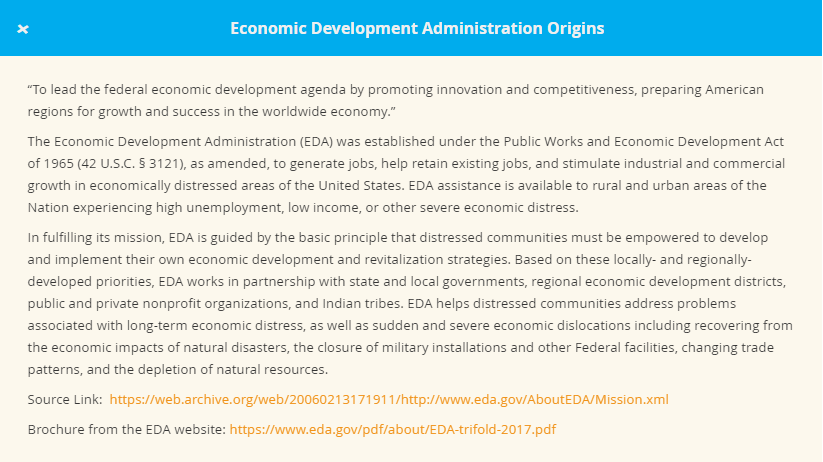
The federal economic development system divides the country into regions and districts.
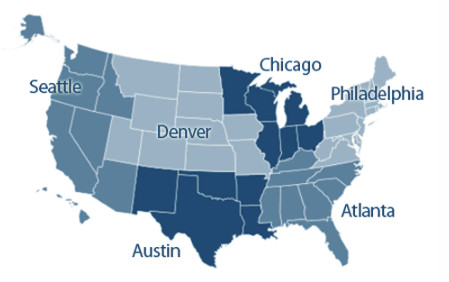
Colorado is divided into fourteen economic development districts. From the map on the right, it appears that thirteen of the development districts have established a ‘Councils of Government’ syndicate:
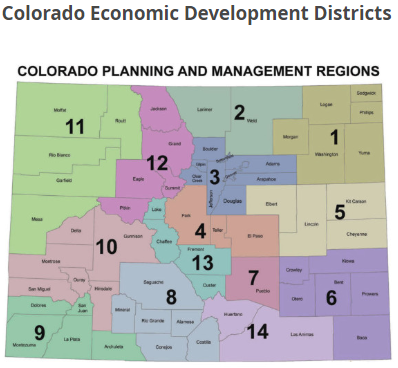
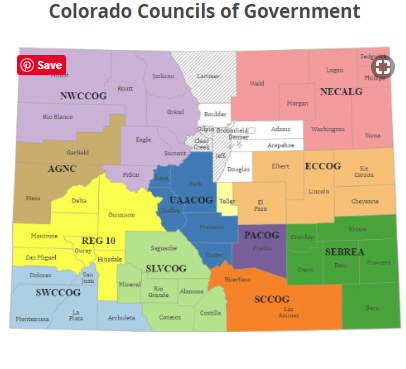
The information page about Region 9 says that their organization includes 9 members from the private sector:
Region 9 Economic Development District of SW Colorado, Inc. is a non-profit, 501(c)6 public/private partnership that promotes and coordinates economic development efforts throughout Southwest Colorado. Incorporated in 1989, Region 9 is led by a board of directors comprised of representatives from the 17 local governmental jurisdictions and 9 from the private sector.
The following is an excerpt from the history of the Southwest Colorado Council of Governments (SWCCOG):
The Region 9 Economic Development District of Southwest Colorado (Region 9) established a Regional Cooperation Committee (RCC) in 2008 and formalized the evolving conversation about forming a Council of Governments in Southwest Colorado. The Region 9 Board is made up from representatives of the 17 governmental jurisdictions, the majority who participated on this RCC group. In early 2009, several local government representatives decided to move ahead with the formation of the SWCCOG. Information was provided at a monthly county/city managers meeting, the RCC group and Region 9 Board meetings. There was recognition about the difficulty to develop long-range planning and topical issues across jurisdictional boundaries, but also recognition that there may be opportunities where it would beneficial to the local governments to do so.
The image of these central economic planning districts presents a completely different picture of the organization of the United States. The Councils of Government and Metropolitan Planning Organizations represent the collectivization of governments above the level and outside the level of elected, representative government. It would be a safe bet that the majority of people are completely unaware of the central economic planners sitting over the top of their local governments. The following is a US map of regional councils.
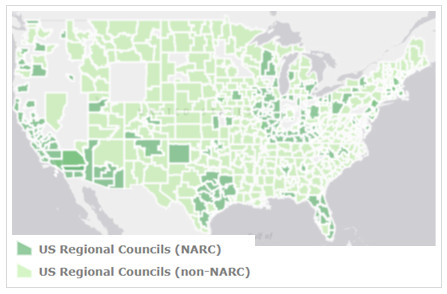
The National Association of Regional Councils (NARC – in name and fact) has a description of both Councils of Government and Metropolitan Planning Organizations on their website. It is an important page to read. Click HERE.
The membership of SWCCOG is comprised of an official designated by the lawful jurisdiction from the jurisdictions that are members. They attend regularly scheduled meetings of the SWCCOG syndicate. “Member jurisdictions must have signed an intergovernmental agreement to vote.
The SWCCOG member jurisdictions are as follows:
Archuleta County
Delores County
La Plata County
San Juan County
City of Cortez
City of Durango
Town of Bayfield
Town of Dolores
Town of Ignacio
Town of Mancos
Town of Pagosa Springs
Town of Rico
Town of Silverton
The Dark Web of the Regional Syndicates
Recently, I became aware of the strategic broadband plan of the SWCCOG – Southwest Colorado Councils of Government.
This plan brings up a lot of significant issues and some very troubling questions – not just for Colorado but for any location that has formally established a regional, governmental, cross-jurisdictional organization – a Councils of Government organization, regional economic central planners ![]() .
.
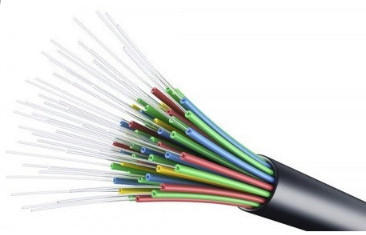 The strategic broadband plan is a marketing report for county and city officials within Economic Development Region 9 emphasizing cost savings through collaborative procurement of dark fiber leased lines. Dark fiber is unused capacity in an existing run of cable. To give you an idea of capacity in a cable, sometime around 1993, nearly 30 years ago, I attended a presentation about fiber optic cable. The presenter had a show-and-tell cable with him. He said each strand is about the size of human hair and had the capacity to handle 100,000 phone calls.
The strategic broadband plan is a marketing report for county and city officials within Economic Development Region 9 emphasizing cost savings through collaborative procurement of dark fiber leased lines. Dark fiber is unused capacity in an existing run of cable. To give you an idea of capacity in a cable, sometime around 1993, nearly 30 years ago, I attended a presentation about fiber optic cable. The presenter had a show-and-tell cable with him. He said each strand is about the size of human hair and had the capacity to handle 100,000 phone calls.
It’s not really the fiber optic cable itself that is expensive. What is expensive is the installation of it and then the on-going costs of the management of the network. In urban areas, there is enough demand to warrant the expense. In rural areas, there isn’t enough demand so costs are high which is the fundamental argument in the report for collective procurement.
The strategic broadband report was produced by a company called NEO Connect.
NEO is located in Colorado. In the Introduction, the report says that it was paid for partially by a grant from the Energy/Mineral Impact Assistance Fund. That’s very intriguing given that the west has a lot of minerals – like water, uranium, etc. What it means, is not known but it seems worth investigating.
The project was made possible by the Colorado Department of Local Affairs, Colorado Department of Transportation, La Plata Economic Development Alliance, Region 9 Economic Development District, and the Southwest Colorado Council of Governments. The scope of work also included making recommendations to put together a sustainable financial plan for the existing Southwest Colorado Access Network (SCAN) project. The following is a video about the SCAN project:
It all sounds very innocent doesn’t it? But is it really?
On page 8 of the report, it says the following:
With 116 anchor institutions currently connected to the SCAN network, the SWCCOG could implement a more favorable revenue model by providing services either directly or indirectly to the anchor institutions.
+What Is An Anchor Institution?
+Anchor Institutions Task Force
+Chamber of Commerce – An Anchor Institution
Economic Studies of the Region
Central economic planning for a communist system of economic management must begin with baseline information on the current economic status of a region. Michael Porter, Harvard University was the key “thought leader” in describing what came to be called Cluster Studies. A cluster study identifies businesses in a region and the relationships between businesses to identify the supply chain structures fo those businesses. The economic planners then use that information to increase the strength of a desired business or to put a business out of business by bringing in competitors using loss leader pricing. The Chamber of Commerce as an anchor institution with a membership of businesses is the facilitator of this aspect of central economic planning behind the rhetorical propaganda of competitiveness. The following are several reports concerning cluster studies and their use:
A Governor’s Guide to Cluster-Based Economic Development
Industry Cluster Analysis: Regional Economic Base: Analysis
In previous work titled, The Organization of Power (Part 3), it was found that the Chamber of Commerce has a subgroup of executive leaders (Association of Chamber of Commerce Executives) and within that subgroup, there is another subgroup called the Alliance for Regional Stewardship. The history of the Alliance can be read HERE. You can go to the current website for ACCE and type in the search box Regionalism or Alliance for Regional Stewardship and you will find more information on their regional activities.
The Competitive Advantage of Nations, Michael E. Porter, 1990
Social Studies of the Region
Obtaining the list of anchor institutions and soliciting their support in the conversion of the economic and social structure of a region to the communist management system is necessary for both obvious and not so obvious reasons. The collectivization of both for-profit and non-profit anchor institutions forms a syndicate – an institutional mafia that operates in the interest of the collective sometimes aligned with the electorate of a region – and sometimes not as in the case of refugee resettlement.
The anchor institutions are comprised of individuals who interests are aligned with the syndicate. When political issues arise as in the case of a piece of legislation in Idaho called S.1067, the institutional syndicate can call out their employees for a show of force against the non-syndicate individuals of the electorate. This is the means by which elected, representative government is subverted by the collective because the collective – the institutional mafia acts in the interest of the collective.
Social Control
Getting back to the Colorado Broadband Plan which you can assume is the same strategic plan for every regional Council of Government (COG), recall that their objective is to connect counties and cities in the COG region plus the anchor institutions together ostensibly to save money and to be more efficient in their regional operations. On page 21 of the Plan, it says the following:
In addition to Internet access services, the SCAN could support data services between locations
connected to the network. These data services provide a very high-speed connection between
two or more locations on the network, without going to the public Internet for Internet services.
So let’s recap. We have a virtually unknown regional syndicate establishing a private communications system outside of the public system with a direct point-to-point private network to which all of the anchor institutions and government entities within the region are connected.
On the same page, Page 21, it says the following:
Enhanced public safety options. Having a fiber connection between, for example, a school and law enforcement can provide critical information during an emergency.
Security cameras can be installed with gunshot detection, allowing law enforcement to receive instant camera and video feeds if a gunshot is fired within a school. First responders can pinpoint who, where and how many shooters are present prior to arriving at the scene.
That might sound like a good idea – but those security cameras can be turned on at any time for the police to surveil and record the activities of the students all the time. In fact, those security camera systems can be installed all over the town and inside syndicate facilities for 24/7 surveillance – the ultimate police state control system.
On the NEO website (recall that NEO is the consulting firm that produced the SWCCOG Broadband Plan), there is a page of links to reports. One of the labels is Environmental Benefits of FTTH Deployments. The report has the very intimidating title: Developing a Generic Approach for FTTH Solutions using Life Cycle Analysis Methodology to Determine Environmental Benefits of FTTH Deployments in the USA. Who wants to read that right? On page 6 of the report, under the heading of Goals and Applications, it includes the following:
The mission of the FTTH Council, North America is to educate stakeholders and to promote and accelerate FTTH solutions. One opportunity to accomplish this goal is to quantify the quality of life enhancements provided via FTTH deployments. The Council would like to develop a standard approach for evaluating FTTH solutions using globally accepted Life Cycle Assessment (LCA) methodology. The goal is to assess FTTH network implementation scenarios using the LCA methodology.
A search on the term FTTH Council brought up some very interesting results.
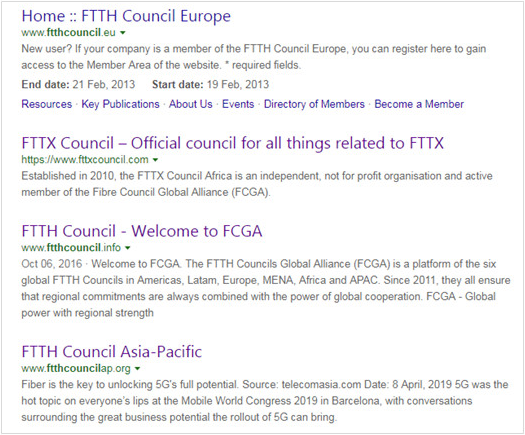
FTTH stands for Fiber to the Home and the Councils are continental and oceanographic regions.
And the FCGA – Fiber to the Home Council Global Alliance
The FTTH Council for the Americas was established in July of 2001 with the name FTTH Council. Apparently, the name was retired and the new name is Fiber Broadband Association. A new related organization was formed in 2017 presumably to put distance between the ideas of a global broadband network system with the ideas of sensors for surveillance and control. The name of the new association is: Fiber Optic Sensing Association. The following are significant excerpts:
Fiber optic sensing can be deployed to continuously monitor vehicle movement, human traffic, digging activity, seismic activity, temperatures, structural integrity, liquid and gas leaks, and many other conditions and activities along a fiber optic cable. Fiber optic sensing is used around the world to monitor smart infrastructure, such as railways, bridges, tunnels, borders, power stations and pipelines. It is also used in downhole oil and gas applications, to help characterize reservoirs and assist in well-optimization during production and completion. The technology is not constrained by line of sight or remote power access and, depending on system configuration, can be deployed in continuous lengths over hundreds of miles with detection at every point along its path. Cost per sensing point over great distances cannot be matched by competing technologies, such as point sensors, and often existing deployed fibers can be utilized.
. . . The Fiber Optic Sensing Association is affiliated with the not for profit Fiber Broadband Association, which provides education on the benefits of fiber optic networks and seeks to advance the deployment and utilization of fiber optic networks for multiple purposes, including sensing, telecommunications, Internet, and SCADA.
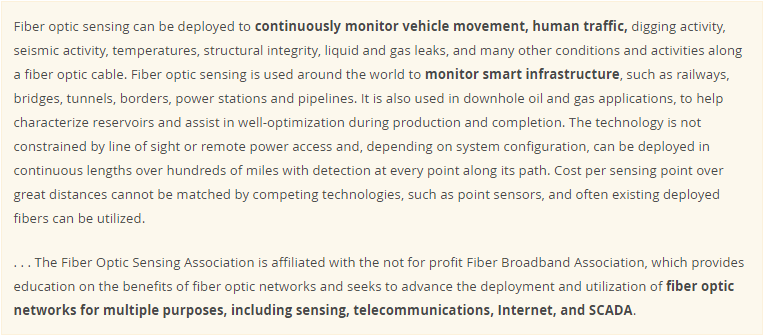
The next article on NEOs website brings all of the elements together in an article about Google and their Broadband Plan. Although the article doesn’t mention Toronto, Canada, it does mention that Google is looking for municipal partners which de facto leads to the Toronto municipal project of the smart city. The Toronto project is an idealized vision of the smart city designed to sell the idea of technology embedded within the infrastructure for convenience when what it really is – is the open air Panopticon, the ultimate system of control for people residing within the perimeters of the control grid all enabled by Broadband and sensors.
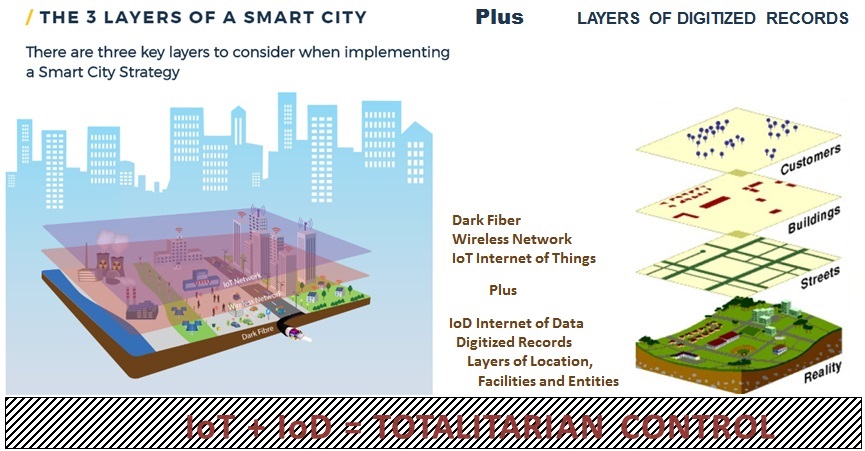
Published with Permission of thetechnochratictyranny.com
